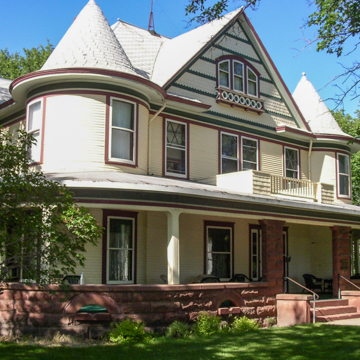You are here
Bieseker Mansion (Thomas L. and Clara Bieseker House)
Thomas Lincoln Bieseker was a banker, politician, newspaper publisher, and land developer, and for a time he directed the Canadian Pacific Railway’s land department in Alberta and British Columbia. The town of Bieseker in Alberta was named in his honor. He established the Wells County Bank, first in Sykeston, and in 1894 he relocated to Fessenden. Bieseker engaged in an extensive mortgage loan business and eventually established twenty-eight financial institutions in North Dakota and Montana. During the Great Depression, he experienced severe losses and was forced to liquidate many of his assets. He saved the Wells County Bank by mortgaging 40,000 acres of his North Dakota lands for $500,000, believed to be the largest personal mortgage on farm property ever filed in the state.
Family tradition attributes the construction and design of this house to Bieseker’s uncle, Henry, a skilled carpenter by trade. Carpenters commuted weekly by train from Minneapolis to work on this house. The balloon-frame house blends Queen Anne and Shingle styles. Atop a fieldstone foundation, the first and second stories are sheathed in narrow clapboard siding and the attic story is shingled. The intersecting gables are adorned by a pair of two-story semicircular turrets with conical roofs and curved glass windows, and by a two-story semi-hexagonal window. A deeply sheltered one-story porch wraps around the front and sides of this house, which now operates as a bed-and-breakfast.
Writing Credits
If SAH Archipedia has been useful to you, please consider supporting it.
SAH Archipedia tells the story of the United States through its buildings, landscapes, and cities. This freely available resource empowers the public with authoritative knowledge that deepens their understanding and appreciation of the built environment. But the Society of Architectural Historians, which created SAH Archipedia with University of Virginia Press, needs your support to maintain the high-caliber research, writing, photography, cartography, editing, design, and programming that make SAH Archipedia a trusted online resource available to all who value the history of place, heritage tourism, and learning.









